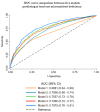Predicting Malnutrition Risk with Data from Routinely Measured Clinical Biochemical Diagnostic Tests in Free-Living Older Populations
- PMID: 34072686
- PMCID: PMC8226876
- DOI: 10.3390/nu13061883
Predicting Malnutrition Risk with Data from Routinely Measured Clinical Biochemical Diagnostic Tests in Free-Living Older Populations
Abstract
Malnutrition (undernutrition) in older adults is often not diagnosed before its adverse consequences have occurred, despite the existence of established screening tools. As a potential method of early detection, we examined whether readily available and routinely measured clinical biochemical diagnostic test data could predict poor nutritional status. We combined 2008-2017 data of 1518 free-living individuals ≥50 years from the United Kingdom National Diet and Nutrition Survey (NDNS) and used logistic regression to determine associations between routine biochemical diagnostic test data, micronutrient deficiency biomarkers, and established malnutrition indicators (components of screening tools) in a three-step validation process. A prediction model was created to determine how effectively routine biochemical diagnostic tests and established malnutrition indicators predicted poor nutritional status (defined by ≥1 micronutrient deficiency in blood of vitamins B6, B12 and C; selenium; or zinc). Significant predictors of poor nutritional status were low concentrations of total cholesterol, haemoglobin, HbA1c, ferritin and vitamin D status, and high concentrations of C-reactive protein; except for HbA1c, these were also associated with established malnutrition indicators. Additional validation was provided by the significant association of established malnutrition indicators (low protein, fruit/vegetable and fluid intake) with biochemically defined poor nutritional status. The prediction model (including biochemical tests, established malnutrition indicators and covariates) showed an AUC of 0.79 (95% CI: 0.76-0.81), sensitivity of 66.0% and specificity of 78.1%. Clinical routine biochemical diagnostic test data have the potential to facilitate early detection of malnutrition risk in free-living older populations. However, further validation in different settings and against established malnutrition screening tools is warranted.
Keywords: biochemical diagnostic tests; micronutrient deficiency biomarker; screening tool; undernutrition.
Conflict of interest statement
The authors declare no conflict of interest.
Figures



Similar articles
-
Dietary inadequacies overestimate the blood deficiencies of magnesium, zinc, and vitamins A, C, E, and D among residents of Sao Paulo.Clin Nutr ESPEN. 2023 Feb;53:196-205. doi: 10.1016/j.clnesp.2022.12.015. Epub 2022 Dec 20. Clin Nutr ESPEN. 2023. PMID: 36657914
-
Nutritional Risk, Micronutrient Status and Clinical Outcomes: A Prospective Observational Study in an Infectious Disease Clinic.Nutrients. 2016 Feb 29;8(3):124. doi: 10.3390/nu8030124. Nutrients. 2016. PMID: 26938553 Free PMC article.
-
Relationships between micronutrient intake and biochemical indicators of nutrient adequacy in a "free-living' elderly UK population.Br J Nutr. 1997 Feb;77(2):225-42. doi: 10.1079/bjn19970026. Br J Nutr. 1997. PMID: 9135369
-
A review of the validity of malnutrition screening tools used in older adults in community and healthcare settings - A MaNuEL study.Clin Nutr ESPEN. 2018 Apr;24:1-13. doi: 10.1016/j.clnesp.2018.02.005. Clin Nutr ESPEN. 2018. PMID: 29576345 Review.
-
Identifying the elderly at risk for malnutrition. The Mini Nutritional Assessment.Clin Geriatr Med. 2002 Nov;18(4):737-57. doi: 10.1016/s0749-0690(02)00059-9. Clin Geriatr Med. 2002. PMID: 12608501 Review.
Cited by
-
Preparing for and Not Waiting for Surgery.Curr Oncol. 2024 Jan 23;31(2):629-648. doi: 10.3390/curroncol31020046. Curr Oncol. 2024. PMID: 38392040 Free PMC article. Review.
-
Phase Angle, Handgrip Strength, and Other Indicators of Nutritional Status in Cancer Patients Undergoing Different Nutritional Strategies: A Systematic Review and Meta-Analysis.Nutrients. 2023 Apr 6;15(7):1790. doi: 10.3390/nu15071790. Nutrients. 2023. PMID: 37049629 Free PMC article.
-
Cross-Sectional Associations between Clinical Biochemistry and Nutritional Biomarkers and Sarcopenic Indices of Skeletal Muscle in the Baltimore Longitudinal Study of Aging.J Nutr. 2025 May;155(5):1535-1548. doi: 10.1016/j.tjnut.2025.03.006. Epub 2025 Mar 8. J Nutr. 2025. PMID: 40064424 Free PMC article.
-
Development and Validation of a Risk Prediction Model for Sarcopenia in Chinese Older Patients with Type 2 Diabetes Mellitus.Diabetes Metab Syndr Obes. 2024 Nov 30;17:4611-4626. doi: 10.2147/DMSO.S493903. eCollection 2024. Diabetes Metab Syndr Obes. 2024. PMID: 39635500 Free PMC article.
-
Prediabetes is associated with loss of appendicular skeletal muscle mass and sarcopenia.Front Nutr. 2023 Mar 1;10:1109824. doi: 10.3389/fnut.2023.1109824. eCollection 2023. Front Nutr. 2023. PMID: 36937340 Free PMC article.
References
MeSH terms
Substances
LinkOut - more resources
Full Text Sources
Medical
Research Materials

